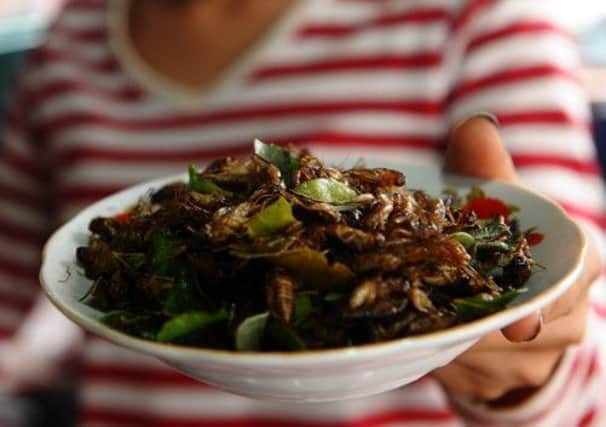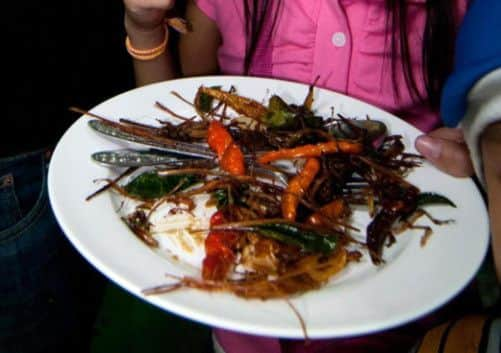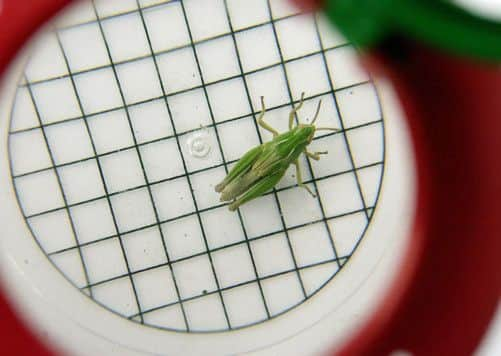How eating insects could solve world hunger


I AM NOT a born bug eater. At the age of six, a big boy cousin informed me that the crispy yellow noodles in Bombay mix were dried worms and proceeded to guzzle them by the handful: an act which thrilled and horrified me in equal measure and one I refused to emulate regardless of the pitiless mockery my squeamishness provoked.
At the age of seven, a smaller boy cousin elected to show me, with the aid of a heavy stone, “what the inside of a snail looks like”. The resulting milky pink emissions recalled something disturbingly familiar and the gooey sight rendered me unable to face strawberry yoghurt for the rest of my childhood. Such was my aversion to anything in a shell, I couldn’t even look a prawn in its beady black eyes until the age of 18.
Advertisement
Hide AdAdvertisement
Hide AdSo, when the day arrived that I found myself deep in the Cambodian jungle and seeking out second helpings of mashed beetle, I realised something fundamental had changed inside me. While not a fully fledged insectivore, I was now someone who consumed creepy-crawlies. There would be no going back.


Before I knew it I was crunching crispy ants, guzzling down spicy grasshoppers, and positively salivating over slippery snails. Actually, I exaggerate about the grasshoppers. I quite like their fresh, leafy, flavour, but I can’t eat them by the bagful the way many people in South East Asia do.
So, when the United Nations announced earlier this month that we could all help world hunger by eating more insects and I saw most of my fellow Scots turn green at the thought, I found myself championing the cause. On the morning of my conversion I had arrived by river at the small tribal village of Kreung people in Ratanakiri province hoping to stay for a few days while researching material for a book.
I was told I would need to receive the permission of the local chief, who was at that point visiting his mother at a smallholding deep in the jungle. A smiling young man in a red-and-white loincloth offered to take me there.
Eventually we reached a small clearing where a little old lady crouched beside a fire in a small wooden shack, with a low door and no windows. My guide offered me a hollowed-out gourd filled with rainwater and I sat down in the shade as he disappeared into the trees.


He returned 20 minutes later, smiling even more than previously, and stood a small distance away glancing over towards me. He’d bunched up the front on his loincloth in his hands and started flicking it in my direction while raising his eyebrows and looking down towards his crotch as if to indicate something exciting was about to occur. Although mildly perturbed, I found it impossible not to follow the direction of his gaze, and it was with relief, as well as surprise, that I saw the 30 or so large shiny black beetles, each about two inches long, which he’d gathered in the folds of the material.
At that moment the chief arrived in the clearing and the beetles slipped from my mind until about 15 minutes later when a bowl of something grey and mushy appeared from the shack, accompanied by a plate of stringy jungle herbs. The beetles had been cooked over the open fire, de-shelled – well mostly, Cambodians do not share our general Western aversion to bones, gristle, shells and the like – then mashed into a paste with fresh chilli.
The chief was watching me intently, and I knew it would not help my accommodation plans were I to refuse his mother’s cooking. Following his lead, I dipped a bunched of herbs into the paté and put it in my mouth. It was like nothing I’d ever tasted. The smoky flavour from the fire and the tangy hot chillies gave an instant hit, but despite those robust flavours, the taste of beetle won through. If it reminded me of anything at all it was the sightly musky flavour that you get from game, or certain offal such as liver. I was not at all sure if I Iiked it.
Advertisement
Hide AdAdvertisement
Hide AdBut, as negotiations with the chief continued, I found myself going back for more. And then again. And again. And by the time my stay in the village had been arranged, the bowl was almost empty.
Insects, according to the UN report, and as understood by generations who have regularly included them in their traditional diet, are “extremely efficient” in converting feed into edible meat. Crickets, by Jiminy, need 12 times less feed than cattle to produce the same amount of protein.
As with cows or soya beans, the mass production of anything, including insects, is unlikely to be entirely without environmental or social consequence. Most edible insects are gathered in forests, the report acknowledges, and one could hardly feed the world with the kind of hunter-gatherer techniques my loincloth-wearing guide used to provide my lunch that day.
But the report, which calls for improved regulation and production for using insects as feed, also notes: “The use of insects on a large scale as a feed ingredient is technically feasible, and established companies in various parts of the world are already leading the way.” And the figures would certainly suggest that, if nothing else, crickets are less likely to contribute to a methane-enduced hole in the ozone layer than their more gaseous dinner-dish rivals, the cows.
From a welfare point of view, the factory farming of ants – those most industrious and communal creatures – would appear to be, on initial observations at least, less traumatic to those animals involved than the intensive farming of the more emotionally sensitive pig. Let us be clear about it: I’ve yet to eat an invertebrate that “tastes like chicken. If Scotland is to get its national head, or teeth, around insect-based dining, we will need to open our collective minds to the idea that meat comes in more varieties than red or white.
But surely this is a good thing? Beef, pork, lamb, chicken, turkey – and if one is feeling alternative, venison or duck – give us seven regular meats. That’s one for each day of the week. Even if the division between consumption of those seven were to be even, which for the vast majority of Scots it is not, that would mean that by the age of 80, if two out of three meals per day contained meat, we’ll have eaten each of those creatures more than 8,000 times. Imagine! It’s enough to make a tastebud die of boredom.
No-one knows exactly how many species of insects there are on earth, but estimates put it at between six and ten million. The odds would seem pretty good, then, that some of them would suit personal tastes.
I have never eaten tarantula, though I’ve seen them often enough – huge, black, and deep fried – on roadside stalls while passing through central Cambodia. But I would give them a go if offered them, and if I don’t like them there are still 9,999,999 or so alternatives to try.
Advertisement
Hide AdAdvertisement
Hide AdRecently, home in Scotland, I was tucking into a plate of snails, cooked French-style with butter and garlic, and as I savoured the delicious mossy woodland flavour I recalled my first snails and the little Indonesian lady who had determinedly pursued me around a lake one day in order to offer me some of the tiny pond molluscs she’d just gathered up. She watched impatiently as I tried to remove one from its shell, before laughingly grabbing it from my hands, sticking in her mouth, crunching it open with her teeth and handing it back.
She did this repeatedly and it took considerable determination to get her to desist, but despite the dubious hygiene, the tiny creatures tasted great.
So if you’ve closed your mind and your mouth to the prospect on eating insects before now, I’d urge you to reconsider. There are about 10m scuttling, fluttering and slithering great reasons out there to do so.